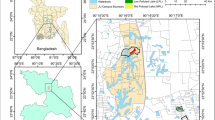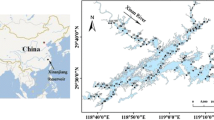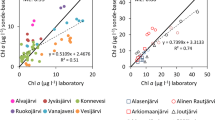Abstract
Development of a technique for rapid field estimation of biochemical oxygen demand (BOD) is necessary for cost-effective monitoring and management of urban lakes. While several studies reported the usefulness of laboratory tryptophan-like fluorescence technique in predicting 5-day BOD (BOD5) of wastewater and leachates, little is known about the predictability of field chlorophyll fluorescence measurements for BOD of urban lake waters that are constantly exposed to the mixture of chemical compounds. This study was conducted to develop a numeric relationship between chlorophyll a fluorescence and BOD for a eutrophic urban lake that is widely representative of lake water conditions in the subtropical southern USA. From October 2012 to September 2013, in situ measurements at the studied lake were made every 2 weeks on chlorophyll a fluorescence and other water quality parameters including water temperature, pH, dissolved oxygen, and specific conductivity. Water samples were taken for 5-day BOD and 10-day BOD (BOD10) analysis with and without incubation. The results showed a clear seasonal trend of both BOD measurements being high during the summer and low during the winter. There was a linear, positive relationship between chlorophyll a fluorescence and BOD, and the relationship appeared to be stronger with the 10-day BOD (r 2 = 0.83) than with the 5-day BOD (r 2 = 0.76). BOD dropped each day with declining chlorophyll a fluorescence, suggesting that die-off of phytoplankton has been the main consumption of oxygen in the studied lake. Ambient conditions such as rainfall and water temperature may have partially affected BOD variation.







Similar content being viewed by others
References
Ahmad, S. R., & Reynolds, D. M. (1999). Monitoring of water quality using fluorescence technique: prospect of on-line process control. Water Research, 33(9), 2069–2074.
APHA. (2005). Standard methods for the examination of water and wastewater (21st ed.). Washington: American Public Health Association.
Arar, E. J., & Collins, G. B. (1997). In vitro determination of chlorophyll a and pheophytin a in marine and freshwater algae by fluorescence. Method 445.0. Cincinnati: National Exposure Research Laboratory, USEPA.
Arora, J., & Mehra, N. K. (2009). Seasonal dynamics of zooplankton in a shallow eutrophic, man-made hyposaline lake in Delhi (India): role of environmental factors. Hydrobiologia, 626(1), 27–40.
Assoc, R. (1991). City Park/University Lakes Management Plan. Baton Rouge: Applied Technology Research Corporation.
Baker, A., & Curry, M. (2004). Fluorescence of leachates from three contrasting landfills. Water Research, 38(10), 2605–2613.
Baker, A., & Genty, D. (1999). Fluorescence wavelength and intensity variations of cave waters. Journal of Hydrology, 217(1–2), 19–34.
Baker, A., & Inverarity, R. (2004). Protein-like fluorescence intensity as a possible tool for determining river water quality. Hydrological Processes, 18(15), 2927–2945.
Basant, N., Gupta, S., Malik, A., & Singh, K. P. (2010). Linear and nonlinear modeling for simultaneous prediction of dissolved oxygen and biochemical oxygen demand of the surface water—a case study. Chemometrics and Intelligent Laboratory Systems, 104(2), 172–180.
Beutler, M., Wiltshire, K. H., Meyer, B., Moldaenke, C., Luring, C., Meyerhofer, M., Hansen, U. P., & Dau, H. (2002). A fluorometric method for the differentiation of algal populations in vivo and in situ. Photosynthesis Research, 72(1), 39–53.
Brack, W., & Frank, H. (1998). Chlorophyll a fluorescence: a tool for the investigation of toxic effects in the photosynthetic apparatus. Ecotoxicology and Environmental Safety, 40, 34–41.
Breitburg, D. L. (1992). Episodic hypoxia in Chesapeake Bay—interacting effects of recruitment, behavior, and physical disturbance. Ecological Monographs, 62(4), 525–546.
Cammack, W. K. L., Kalff, J., Prairie, Y. T., & Smith, E. M. (2004). Fluorescent dissolved organic matter in lakes: relationships with heterotrophic metabolism. Limnology and Oceanography, 49(6), 2034–2045.
Caraco, N. F., & Cole, J. J. (2002). Contrasting impacts of a native and alien macrophyte on dissolved oxygen in a large river. Ecological Applications, 12(5), 1496–1509.
Carlson, R. E. (1977). A trophic state index for lakes. Limnology Oceanography, 22, 361–369.
Carpenter, S. R., Caraco, N. F., Correll, D. L., Howarth, R. W., Sharpley, A. N., & Smith, V. H. (1998). Nonpoint pollution of surface waters with phosphorus and nitrogen. Ecological Applications, 8(3), 559–568.
Cârstea, E.M. (2012). Fluorescence spectroscopy as a potential tool for in-situ monitoring of dissolved organic matter in surface water systems. In N. Balkis (ed.) Water pollution, InTech, Rijeka
Cârstea, E. M., Ghervasea, L., Pavelescua, G., & Iojăb, C. I. (2012). Dissolved organic matter fluorescence and several metals concentration in a freshwater system. Procedia Environmental Sciences, 14, 41–48.
Christoffers, D., & Ernst, W. (1983). The in-vivo fluorescence of chlorella fusca as a biological test for the inhibition of photosynthesis. Toxicological and Environmental Chemistry, 7, 61–71.
Coble, P. G. (1996). Characterization of marine and terrestrial DOM in seawater using excitation emission matrix spectroscopy. Marine Chemistry, 51(4), 325–346.
Comber, S. D. W., Gardner, M. J., & Gunn, A. M. (1996). Measurement of absorbance and fluorescence as potential alternatives to BOD. Environmental Technology, 17(7), 771–776.
Dodds, W. K., Jones, J. R., & Welch, E. B. (1998). Suggested classification of stream trophic state: distributions of temperate stream types by chlorophyll, total nitrogen, and phosphorus. Water Research, 32(5), 1455–1462.
French, T. D., & Petticrew, E. L. (2007). Chlorophyll a seasonality in four shallow eutrophic lakes (northern British Columbia, Canada) and the critical roles of internal phosphorus loading and temperature. Hydrobiologia, 575, 285–299.
Frodge, J. D., Thomas, G. L., & Pauley, G. B. (1990). Effects of canopy formation by floating and submergent aquatic macrophytes on the water-quality of two shallow pacific-northwest lakes. Aquatic Botany, 38(2–3), 231–248.
Gray, J. S., Wu, R. S. S., & Or, Y. Y. (2002). Effects of hypoxia and organic enrichment on the coastal marine environment. Marine Ecology Progress Series, 238, 249–279.
Gregor, J., & Marsalek, B. (2004). Freshwater phytoplankton quantification by chlorophyll alpha: a comparative study of in vitro, in vivo and in situ methods. Water Research, 38(3), 517–522.
Hamilton, S. K., Sippel, S. J., Calheiros, D. F., & Melack, J. M. (1997). An anoxic event and other biogeochemical effects of the Pantanal wetland on the Paraguay River. Limnology and Oceanography, 42(2), 257–272.
Harrison, J. A., Matson, P. A., & Fendorf, S. E. (2005). Effects of a diel oxygen cycle on nitrogen transformations and greenhouse gas emissions in a eutrophied subtropical stream. Aquatic Sciences, 67(3), 308–315.
Hudson, N., Baker, A., & Reynolds, D. (2007). Fluorescence analysis of dissolved organic matter in natural, waste and polluted waters—a review. River Research and Applications, 23(6), 631–649.
Hudson, N., Baker, A., Ward, D., Reynlds, D. M., Brunsdon, C., Carliell-Marquet, C., & Browning, S. (2008). Can fluorescence spectrometry be used as a surrogate for the biochemical oxygen demand (BOD) test in water quality assessment? An example from South West England. Science of the Total Environment, 391(1), 149–158.
Kemp, W. M., Sampou, P., Caffrey, J., Mayer, M., Henriksen, K., & Boynton, W. R. (1990). Ammonium recycling versus denitrification in Chesapeake Bay sediments. Limnology and Oceanography, 35(7), 1545–1563.
Kwak, J., Khang, B., Kim, E., & Kim, H. (2013). Estimation of biochemical oxygen demand based on dissolved organic carbon, UV absorption, and fluorescence measurements. Journal of Chemistry, 9.
Mesmer, R. (2010). Impact of urban runoff of phosphorus, nitrogen and dissolved oxygen in a shallow subtropical lake. Master Thesis, Louisiana State University and Agricultural and Mechanical College.
Patel-Sorrentino, N., Mounier, S., & Benaim, J. Y. (2002). Excitation-emission fluorescence matrix to study pH influence on organic matter fluorescence in the Amazon basin rivers. Water Research, 36(10), 2571–2581.
Reynolds, D. M. (2002). The differentiation of biodegradable and non-biodegradable dissolved organic matter in wastewaters using fluorescence spectroscopy. Journal of Chemical Technology and Biotechnology, 77(8), 965–972.
Reynolds, D. M., & Ahmad, S. R. (1997). Rapid and direct determination of wastewater BOD values using a fluorescence technique. Water Research, 31(8), 2012–2018.
Schalles, J. F., Gitelson, A. A., Yacobi, Y. Z., & Kroenke, A. E. (1998). Estimation of chlorophyll a from time series measurements of high spectral resolution reflectance in an eutrophic lake. Journal of Phycology, 34(2), 383–390.
Stevens, P. W., Blewett, D. A., & Casey, J. P. (2006). Short-term effects of a low dissolved oxygen event on estuarine fish assemblages following the passage of Hurricane Charley. Estuaries and Coasts, 29(6A), 997–1003.
Thomas, J. D. (1997). The role of dissolved organic matter, particularly free amino acids and humic substances, in freshwater ecosystems. Freshwater Biology, 38(1), 1–36.
US EPA. (2009). National lakes assessment: a collaborative survey of the nation’s lakes. Washington: Environmental Protection Agency.
Wang, X. L., Lu, Y. L., He, G. Z., Han, J. Y., & Wang, T. Y. (2007). Exploration of relationships between phytoplankton biomass and related environmental variables using multivariate statistic analysis in a eutrophic shallow lake: a 5-year study. Journal of Environmental Sciences-China, 19(8), 920–927.
Whitehead, P. G., Wilby, R. L., Battarbee, R. W., Kernan, M., & Wade, A. J. (2009). A review of the potential impacts of climate change on surface water quality. Hydrological Sciences Journal-Journal Des Sciences Hydrologiques, 54(1), 101–123.
Xu, Y. J., & Mesmer, R. (2013). The dynamics of dissolved oxygen and metabolic rates in a shallow subtropical urban lake, Louisiana, USA. In A. Berit (Ed.), Understanding freshwater quality problems in a changing world (pp. 212–219). Wallingford: IAHS Publication 361.
Zhang, Y. L., & Qin, B. Q. (2001). Study prospect and evolution of eutrophication in Taihu Lake. Shanghai Environmental Sciences, 20, 263–265.
Acknowledgments
This study partially benefited from USDA McIntire–Stennis funds. The authors acknowledge Christopher Mariani’s assistance with field water sampling and Abram DaSilva’s assistance with the laboratory analysis of chlorophyll a. Thanks also go to the Louisiana Agriclimatic Information System for making the long-term weather data available for this study.
Author information
Authors and Affiliations
Corresponding author
Rights and permissions
About this article
Cite this article
Xu, Z., Xu, Y.J. Rapid field estimation of biochemical oxygen demand in a subtropical eutrophic urban lake with chlorophyll a fluorescence. Environ Monit Assess 187, 4171 (2015). https://doi.org/10.1007/s10661-014-4171-1
Received:
Accepted:
Published:
DOI: https://doi.org/10.1007/s10661-014-4171-1




